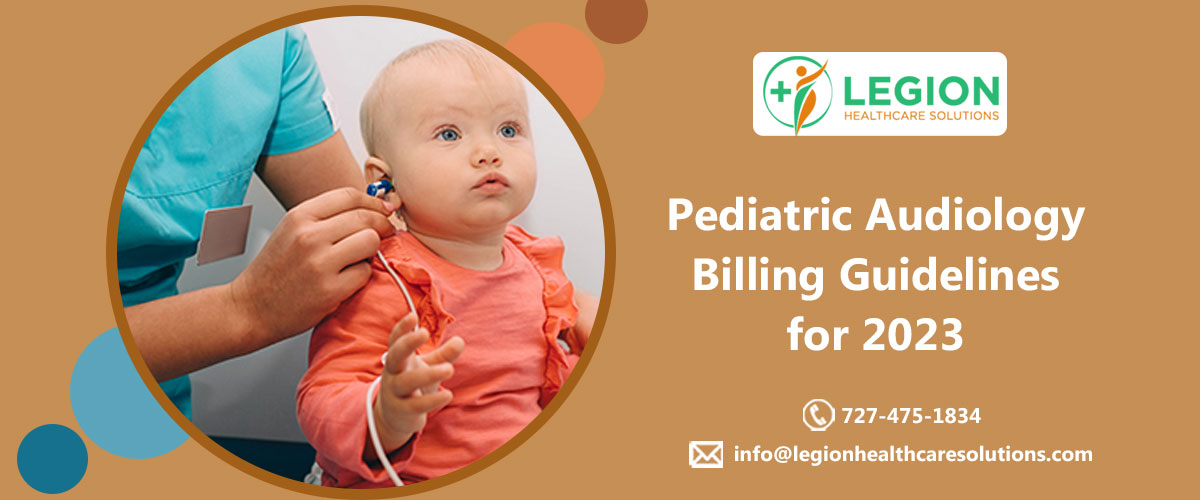
Pediatric Audiology Billing Guidelines for 2023
Basics of Pediatric Audiology Billing Guidelines
Pediatric audiology billing guidelines can be confusing as it varies from one insurance carrier to another. The following pediatric audiology billing guidelines includes commonly used diagnosis/procedure codes, and their billing scenarios. Procedure code guidance is based on the American Medical Association’s Current Procedural Terminology (CPT®) coding definitions. The pediatric audiology billing guidelines shared in this article mostly applies to Medicare. Medicaid and other commercial insurance carriers might include, omit, or further define codes for billing the benefits they allow. Always check your patients’ health plan coverage and payer specific guidelines to avoid claim denials.
Pediatric Audiology Billing Guidelines for 2023
Diagnosis Code for Newborn Hearing Re-screening
The diagnosis code (ICD-10-CM) for newborn hearing re-screening is Z01.110 (Encounter for hearing examination following failed hearing screening). As per ICD-10 CM, this diagnosis code is included under “Encounter for Hearing Examination Following Failed Hearing Screening” as a primary diagnosis code for newborn hearing follow-up testing. Some state programs and commercial insurance carriers might require an ICD-10-CM diagnosis code such as “Unspecified Hearing Loss”, even when test results are normal. So you need to confirm with your payer regarding diagnosis coding requirements for newborn hearing re-screening.
Visual Audiometry and Conditioning Play Audiometry
Procedure codes 92579 (i.e., Visual Audiometry) (VRA) and 92582 (i.e., Conditioning Play Audiometry) (CPA) describe specific, independent pediatric test procedures. These two codes are differentiated by the method of response reinforcement used and the types of stimuli that are considered part of the procedure. These codes currently do not have detailed code descriptions. Description of VRA test procedures included both speech and tonal stimuli as part of the test protocol. In contrast, CPA test protocols included tonal stimuli but did not include speech stimuli.
If CPA testing is completed and speech measures are performed as part of the evaluation, then a code that best describes the speech measure, such as speech threshold audiometry (92555), select picture audiometry (92583), or speech audiometry threshold with speech recognition (92556), can also be reported. Generally, these codes should not be used in addition to pure tone audiometry, air only (92552) or air and bone donduction audiometry (92553) to indicate a method of testing.
Limited or No Audiologic Test Results
It’s challenging to bill limited or no audiologic test results as the codes that you select should accurately reflect the procedures, techniques, and effort that were used, not specifically the number of responses that were obtained. In spite of frequent reconditioning or test reinstruction, you might obtain limited audiologic information. In such cases the audiologist has used considerable effort, various procedures, and/or different reinforcement techniques to obtain those limited results. So, these services would not be considered a reduced service.
To receive accurate reimbursements, documentation of the test session should include the efforts made to obtain test results. You can document a time notation in the patient’s medical record as an estimate of the time and effort involved when limited audiologic information is obtained. There may be a number of reasons why no audiologic results are obtained. However, in a situation where a child is completely uncooperative with any test procedure, the audiologist has a choice of cancelling the appointment altogether or using a reduced service modifier (-52) to indicate that the entire protocol associated with the diagnostic procedure was not completed.
Middle Ear Function Test
Four procedure codes are available to report middle ear function tests that were frequently performed together on the same date of service.
- CPT code 92567: Tympanometry (impedance testing)
- CPT code 92568: Acoustic reflex testing, threshold
- CPT code 92550: Tympanometry and reflex threshold measurements
- CPT code 92570: Acoustic immittance testing, includes tympanometry (impedance testing), acoustic reflex threshold testing, and acoustic reflex decay testing
If acoustic reflex threshold testing or acoustic reflex threshold testing and acoustic reflex decay testing are performed on the same date of service as tympanometry, you must report the bundled code that describes what has been performed. You may not report tympanometry (92567) and acoustic reflex threshold testing (92568) separately on the same date of service.
The tympanometry-only procedure code (92567) should be used if wideband reflectance or multi-frequency tympanometry tests are completed. The code is a session-based code, meaning that 92567 can only be billed one time per day, even if standard and multi-frequency tympanometry as well as wideband reflectance testing are all completed on the same day. An extended service modifier (-22) could be considered when multi-frequency tympanometry and wideband reflectance testing are completed on the same day.
Otoacoustic Emissions (OAE) Testing
The CPT codes 92558, 92587, and 92588 are used to clearly describe the differences between screening OAE and limited versus comprehensive OAE evaluation. The OAE codes assume that testing is completed in both ears. You have to use modifier -52 (reduced service) to the CPT code for unilateral testing.
Auditory Brainstem Response (ABR) Testing
The CPT codes 92650, 92651, 92652 and 92653 are used to report auditory brainstem response (ABR) screening and testing. The auditory evoked potential (AEP) testing codes assume that testing is completed in both ears. As mentioned earlier, you have to use modifier -52 (reduced service) to the CPT code for unilateral testing.
If you perform threshold-search ABR and auditory steady-state response (ASSR) testing on the same day, you have to use procedure code 92652, which is the most appropriate code for billing ASSR at this time. ASSR is considered to be a type of auditory evoked potential (AEP) test and currently does not have a specific CPT code. An extended service modifier (-22) could be considered when both ABR and ASSR are completed on the same day, but only if the time and work to perform AEP testing is substantially greater than usual.
Auditory Processing Evaluation and Aural Rehabilitation Status
CPT codes 92620 and 92621 represent auditory processing evaluation while CPT codes 92626 and 92627 represent evaluation of aural rehabilitation status. For example, first bill CPT code 92620 (i.e., evaluation of central auditory function, with report; initial 60 minutes), then report CPT 92621 for each additional 15 minutes of evaluation time. CPT codes 92626 and 92627 reflect the evaluation of a child’s ability to use residual hearing with an auditory implant, such as a cochlear implant. 92626 and 92627 cannot be used as counseling codes or services unrelated to pre- or post-implant auditory function evaluation.
Legion Healthcare Solutions is a leading medical billing company providing complete billing and coding services. We shared pediatric audiology billing guidelines for physician education purpose, for detailed understanding you can refer the ASHA (American Speech-Language-Hearing Association) article. In case of any assistance required for medical billing and coding services, contact us at 727-475-1834 or email us at info@legionhealthcaresolutions.com
Get A Quote
[forminator_form id=”4528″]
